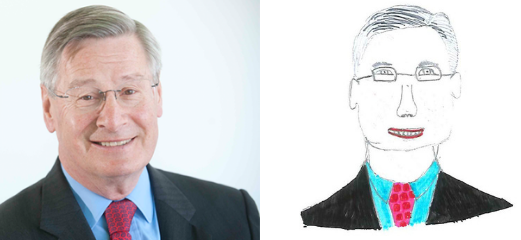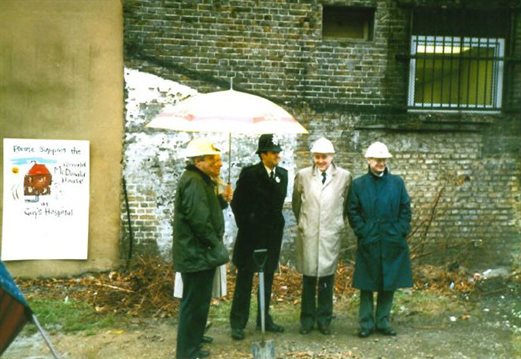
Sir Cyril Chantler explains how accommodation for families has improved at Evelina London.
It was 1961 when I first arrived at Evelina Children’s Hospital on Southwark Bridge Road as a medical student. It was a happy place, small hospitals usually were. It was my experience there that led me to a career as a paediatrician.
There was a single registrar, an Australian doctor called Bruce Storey, who was a wonderful and enthusiastic teacher. The memory of the kindness, concern, knowledge and experience of the paediatricians working there has stayed with me to this day. These excellent doctors included Dr Ronnie MacKeith, one of the UK’s first specialists in child development who established child development centres, and Mr Rex Lawrie, one of the outstanding surgeons of that time.
Rex operated on newborn babies with pyloric stenosis, a condition where the passage between the stomach and the small intestine is narrowed at birth. The operation was under local anaesthetic and the senior sister, Audrey Crump, acted as the anaesthetist, comforting the child with a baby’s dummy containing honey and whisky (or it may have been brandy)! At the time, the removal of the tonsils was a common and potentially dangerous operation, made more so by the distress of the children waking from the anaesthetic without the comfort of their parents. Visiting, even by parents, was limited to certain hours and was not allowed on the same day as an operation; I was shocked. Even Ronnie MacKeith, who pioneered open visiting for the parents on all the medical wards, was unable to change the policy on the surgical ward. It was Ronnie who established the cubicle for the mother and child in Dickens Ward at Guy’s, which was the first in London.
It was then that I first appreciated the importance of specialised paediatric services and the need for the children to be treated as children in properly organised accommodation, rather than in hospitals organised for adults.
There was a hospital school organised by the Inner London Education Authority both at the Evelina and at Guy’s so that children did not fall behind in their work whilst in hospital. This again was a first in London. My colleagues and I argued and indeed campaigned for specialised nurses, and for parents to be welcomed at all times to provide love and support for their children. The harmful long-term psychological damage to the child that can be caused by separation from the parents was becoming clear from the research carried out at the Tavistock Clinic by psychoanalysts James and Joyce Robertson. In my day, their film “a two-year-old goes to hospital” was shown to all new students seeking to learn about children. Basically, the message was to make life in hospital as similar to life at home as possible.
However, there were deficiencies; small hospitals simply could not support the specialisation and technology that has done so much to change the outcomes for children with serious illnesses over the last 50 years. One example, is the danger of cross infection. At the original Evelina hospital on Southwark Bridge Road in the 1960s, we would lose one or two babies each year due to infectious gastroenteritis. This was in spite of them being nursed in separate cubicles with full barrier precautions.
In 1971, I was awarded a travelling research fellowship by the Medical Research Council to study why children with kidney failure did not grow and mature. I went to work at the University of California, and it was here that I first encountered Ronald McDonald Houses, which provided residential facilities for parents alongside the hospitals. I wondered if the same could be done in the UK to help keep families together.
I returned to London to take up my appointment as senior lecturer in paediatrics and consultant paediatrician in 1972. In 1975, the Evelina moved to the new Guy’s Tower at Guy’s Hospital. On our top floor, we had a flat for parents, teaching accommodation and a laboratory. The laboratory became the biochemistry research unit, where we and especially Dr (now Professor) Neil Dalton, were able to carry out research to improve outcomes for children with kidney disease. On the same floor, we had six cubicles for children with infections such as gastroenteritis. Now, these patients had their own air-conditioning and bathroom facilities, and the air from the cubicles was discharged to the outside, rather than back into the hospital. We had no cases of cross infection ever again.
My involvement in campaigning for children’s specialised services continued. The move to Guy’s had provoked a debate. Where should children’s hospitals be located and how should they be organised? I remember the superintendent at Guy’s asking me what I wanted. I said that we wanted accommodation designed for children and families, with space for parents to stay in the hospital, where necessary, with their children. We needed a special children’s operating theatre with a special anaesthetic room for children where the parents could stay with their child until he or she was anaesthetised and be there with the child when they woke up. I think my own eldest son was the first child where a parent was there when he was anaesthetised, largely because my wife refused to leave his side; fortunately the anaesthetist, the wonderful Dr Carnegie, agreed.
The big problem arose when we argued that children should have their own casualty department, which was unknown at that time. An area occupied by the hospital bank on the ground floor of New Guy’s House near to the adult accident and emergency department was identified. We were promised that it could be turned into the children’s casualty open 12 hours a day with a special enclosed area for children and families in the adult A&E used at night. After some contention at the last minute, this eventually happened. A children’s intensive care unit came later.
Accommodation for parents continued to be an issue; the hospital rented a flat in a council block behind Guy’s but there was limited space. I recalled my encounter with Ronald McDonald House in USA, and contacted them to ask if the same could be done here. They went quiet for around two years, then came back and said yes!
I knew that Southwark Council had a site in Snowsfields, just behind New Guy’s House, which would be perfect. They said they would only sell it for a good cause. Guy’s Hospital initially wanted it for staff accommodation, but we argued we needed it for families. We eventually persuaded McDonald’s to build the first Ronald McDonald house in England.
 I was very pleased in 2005, when our hospital services for children moved from Guy’s to the St Thomas’ site, that we were recognised as Evelina London Children’s Hospital. I was also delighted when, in 2017, we opened our new Ronald McDonald House at Evelina London. This was opened by the Duchess of Cambridge, now our Patron, and provides support to families to this day. It really is symbolic of the family centric values Evelina London has carried throughout its history, despite being based across different sites. It is simply part of our culture.
I was very pleased in 2005, when our hospital services for children moved from Guy’s to the St Thomas’ site, that we were recognised as Evelina London Children’s Hospital. I was also delighted when, in 2017, we opened our new Ronald McDonald House at Evelina London. This was opened by the Duchess of Cambridge, now our Patron, and provides support to families to this day. It really is symbolic of the family centric values Evelina London has carried throughout its history, despite being based across different sites. It is simply part of our culture.
Last year, we celebrated 50 years since the first kidney transplant in a child was carried out at Guy’s Hospital; the recipient and her grown-up family were there!

Thank you to the children and young people who have so brilliantly illustrated our history pages.